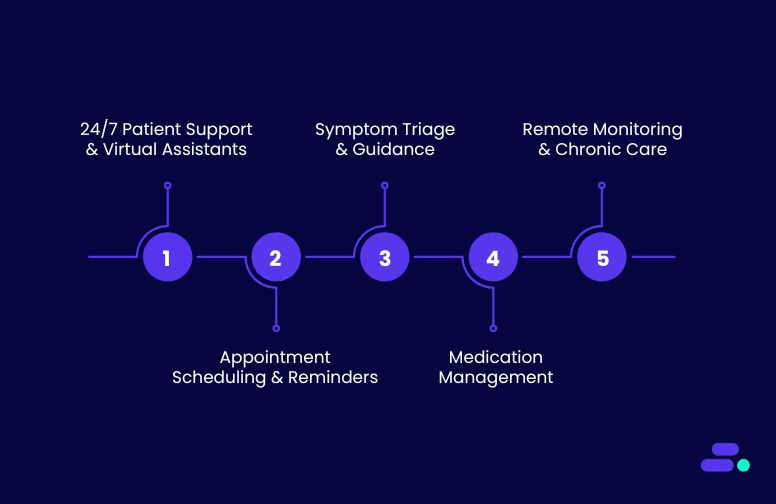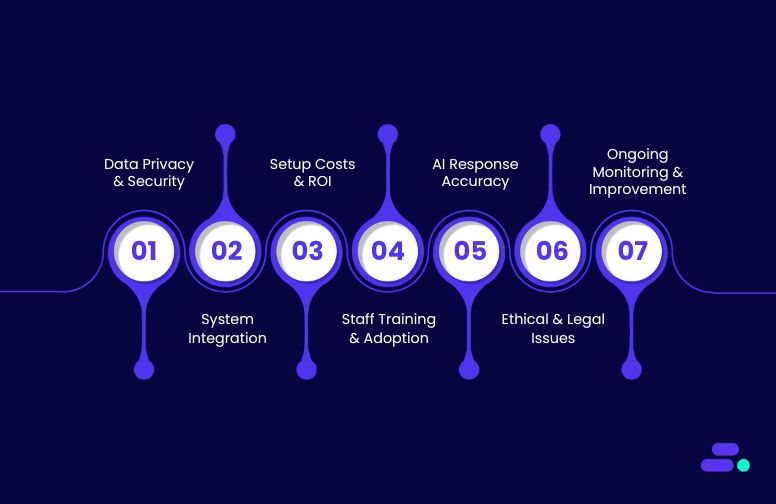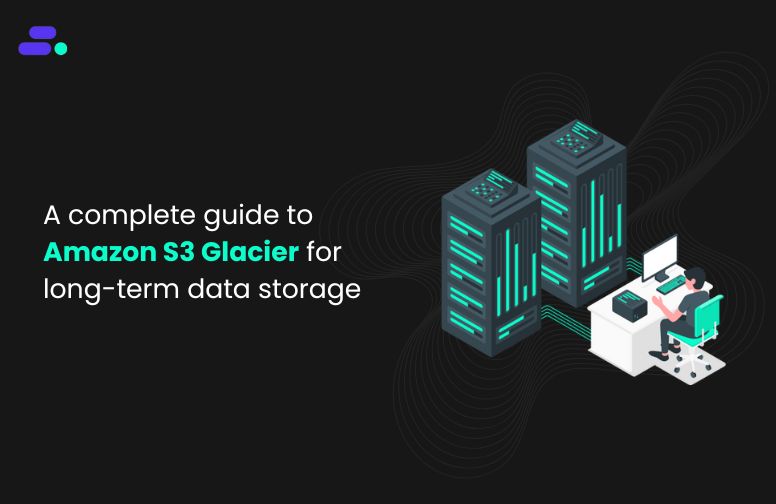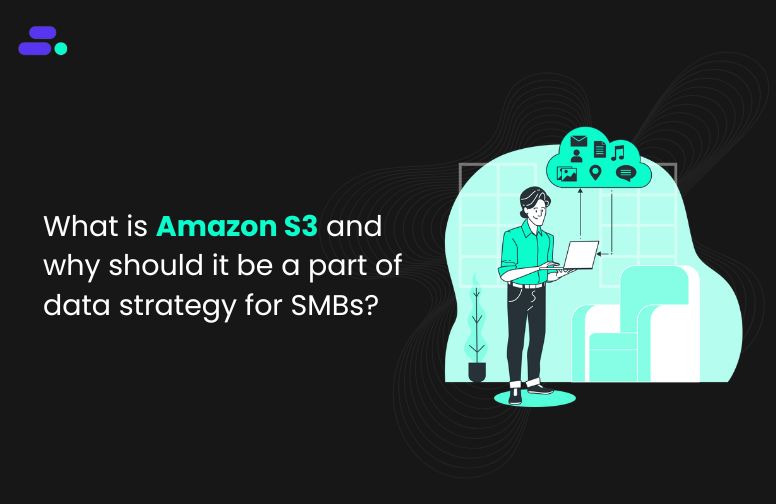This is a div block with a Webflow interaction that will be triggered when the heading is in the view.

Modernize your cloud. Maximize business impact.
Running IT infrastructure on-premises is costly and unreliable, especially for highly regulated sectors like healthcare providers that must keep patient data secure, compliant, and always accessible. By shifting to the cloud, SMBs gain scalability, resilience, and built-in compliance that outdated servers can’t provide.
Consider a small clinic relying on on-prem servers for electronic health records. When systems crash, staff can’t access files, appointments are delayed, and compliance risks grow. But with the cloud, records remain secure and available anytime, downtime is minimized, and regulatory controls are streamlined, freeing staff to focus on patient care instead of server maintenance.
This article explores why SMBs, especially in critical sectors like healthcare, can’t afford to stay on-prem and how cloud technology enables efficiency, security, and growth.
Key takeaways:
- On-premises is costly and rigid: High capital expenses and slow scalability limit SMB growth.
- Cloud unlocks flexibility: AWS delivers pay-as-you-go scalability that matches evolving business needs.
- Security and compliance are stronger in the cloud: Continuous monitoring and built-in governance reduce risk.
- Resilience is built-in: Multi-AZ architecture and automated backups ensure uptime and fast recovery.
- Cloudtech makes the shift seamless: With AWS expertise and an SMB-first approach, Cloudtech ensures adoption is efficient, secure, and ROI-driven.
Why is on-prem no longer suitable for SMBs?
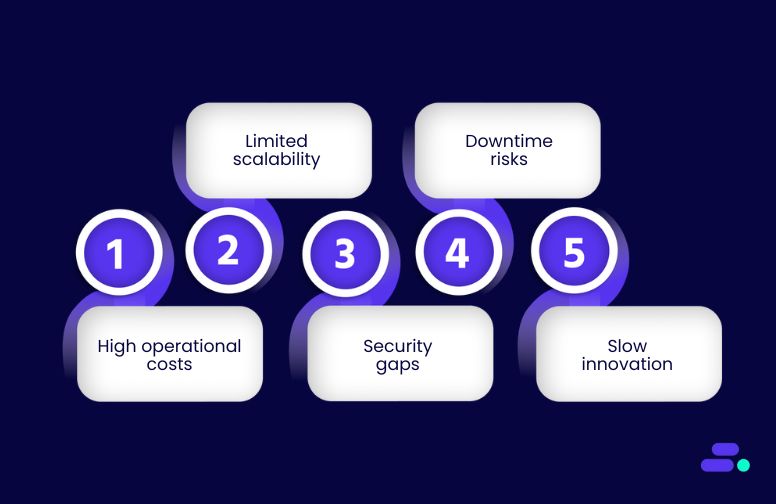
On-premises infrastructure may have once provided SMBs with control and predictability, but in 2025, it is increasingly becoming a liability. Maintaining physical servers requires capital-intensive investments, constant upkeep, and dedicated expertise.
These are resources that most SMBs simply don’t have. Beyond the cost, the inflexibility of on-prem systems leaves smaller businesses struggling to keep pace with digital-first competitors.
The challenges of staying on-prem:
- High operational costs: Hardware procurement, data center power, cooling, and maintenance quickly eat into tight budgets, with no pay-as-you-go flexibility.
- Limited scalability: Expanding capacity often takes weeks of procurement and configuration, while underutilized resources still drain expenses.
- Security gaps: With threats evolving rapidly, small IT teams often can’t keep up with regular patching, monitoring, and compliance requirements.
- Downtime risks: Hardware failures, outages, or local disasters can halt operations, and recovery from on-prem backups may take days.
- Slow innovation: Reliance on legacy infrastructure makes it harder to adopt modern tools like AI, analytics, or automation that competitors are leveraging.
In short, on-prem environments are no longer a competitive advantage for SMBs, but a bottleneck. The businesses that continue to rely solely on them risk higher costs, weaker security, and slower growth in an increasingly cloud-driven world.

5 ways the cloud outperforms on-prem for modern SMBs
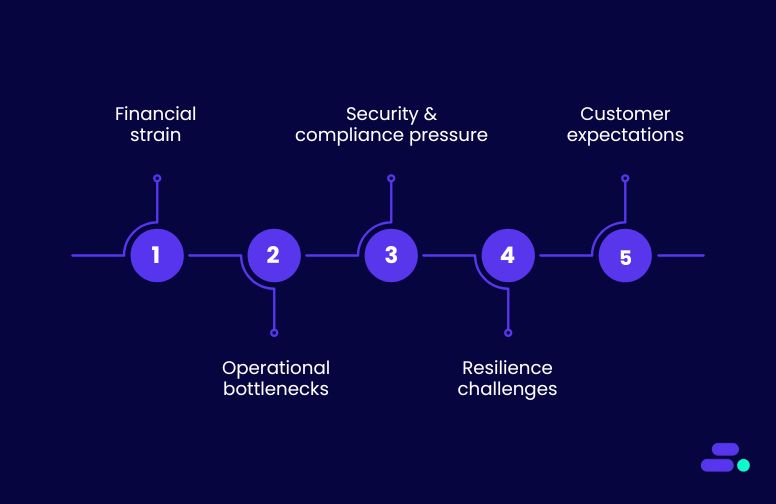
The debate between cloud and on-prem is no longer about ‘if’ but ‘when.’ Traditional infrastructure locks businesses into rigid, costly, and resource-heavy models that can’t keep up with modern demands. Cloud technology, by contrast, gives SMBs the ability to operate with enterprise-grade resilience, security, and agility, without the overhead of managing physical servers.
Adopting the cloud isn’t just a technical upgrade; it’s a shift in how businesses build, scale, and compete. With on-demand resources, automated security, and seamless integrations, SMBs can focus on growth instead of maintenance. Cloud adoption also opens the door to advanced capabilities like AI, analytics, and automation that are impractical on legacy systems.
Along with these benefits of the cloud over on-prem infrastructure, there are some key reasons why SMBs are making their cloud transition:
1. Financial strain: “Owning” IT hardware can become a cost trap
For SMBs, on-prem infrastructure often feels like a financial anchor. Beyond the initial purchase of servers and hardware, maintaining an on-prem environment demands continuous capital outlay. Equipment refresh cycles, licensing renewals, and energy costs stack up, making it difficult for smaller businesses to predict and control IT expenses. What starts as a “one-time investment” quickly turns into an ongoing financial liability.
How the financial strain manifests:
- Capital-heavy spending: Hardware, storage arrays, backup systems, and cooling facilities require upfront investment and frequent refresh cycles.
- Unpredictable maintenance costs: Repairs, vendor support contracts, and emergency replacements consume budgets unexpectedly.
- Low ROI on idle capacity: Businesses must overprovision to prepare for peak loads, but much of that infrastructure sits underutilized during normal operations.
How AWS helps overcome this strain: AWS replaces unpredictable capital expenditures with pay-as-you-go pricing, enabling SMBs to pay only for the compute, storage, or networking resources they actually use.
Services like Amazon EC2 allow businesses to scale capacity up or down in minutes without overprovisioning. Amazon S3 eliminates expensive storage arrays by providing secure, virtually unlimited cloud storage, while AWS Cost Explorer helps track and optimize usage, ensuring spend directly aligns with business demand.
Use case example: A regional logistics SMB struggles with rising costs of maintaining on-prem servers for its shipment tracking platform. The company spends heavily on storage upgrades, cooling, and downtime recovery.
After migrating to Amazon EC2, RDS, and S3, it shifts from large upfront purchases to predictable monthly operating expenses. Idle capacity is eliminated, uptime improves, and the IT budget is freed up to fund digital initiatives like real-time tracking and customer experience improvements.
2. Operational bottlenecks: On-prem can slow SMB agility and flexibility
On-premises systems often act as roadblocks to agility. Unlike the cloud, scaling on-prem resources is tied to physical processes, ordering, shipping, installing, and configuring hardware. These delays introduce downtime, stall projects, and limit an SMB’s ability to respond quickly to market demands. In industries where speed translates directly to competitiveness, the operational drag of on-prem infrastructure becomes a serious liability.
How the bottlenecks manifest:
- Slow scaling cycles: Expanding capacity requires hardware procurement, which can take weeks or months, leading to stalled projects.
- Unavoidable downtime: System upgrades, storage expansions, and migrations often require maintenance windows that disrupt business operations.
- Innovation delays: Developers and business teams must wait for infrastructure availability, preventing quick experimentation or deployment of new solutions.
How AWS removes these bottlenecks: With AWS, scaling is elastic and near-instant. Amazon EC2 Auto Scaling provisions new compute capacity automatically as workloads grow, while Amazon S3 provides virtually unlimited storage without manual intervention.
AWS Lambda allows teams to run code serverlessly without worrying about infrastructure provisioning at all. This means SMBs can launch pilots, expand workloads, and pivot strategies in days, not months.
Use case example: A healthcare SMB running an on-prem patient management system faces constant delays when expanding storage for patient records and analytics. Each upgrade involves procurement cycles and scheduled downtime, frustrating clinicians and IT alike.
After migrating to AWS using Amazon S3 for storage and EC2 Auto Scaling for compute, the company can instantly expand capacity as records grow. Downtime is eliminated, developers roll out new features faster, and the organization keeps pace with patient demands without IT bottlenecks.

3. Security and compliance pressure: On-prem can leave SMBs exposed to threats
SMBs today operate in a regulatory environment that is becoming more complex by the year. This can be HIPAA for healthcare, PCI DSS for payments, GDPR for data protection, and industry-specific mandates. On-premises systems often struggle to keep up because every patch, update, and compliance control has to be handled manually.
For SMBs without large security teams, this means increased risk exposure, audit failures, and potential breaches that could damage both finances and trust.
How the pressure manifests:
- Patch management gaps: Security patches for servers, databases, and firewalls often lag due to limited staff capacity, leaving vulnerabilities open.
- Audit complexity: Proving compliance requires extensive logs and reports, which on-prem systems rarely generate automatically.
- Limited expertise: SMB IT teams often lack specialized compliance and cybersecurity skills, creating blind spots that attackers can exploit.
How AWS strengthens security and compliance: AWS provides built-in security and compliance frameworks, with over 100 certifications including HIPAA, SOC, and GDPR readiness. Tools like AWS Config and AWS Audit Manager automate compliance tracking, while Amazon GuardDuty and AWS Security Hub provide continuous monitoring and threat detection.
Managed services like AWS Backup and IAM (Identity and Access Management) enforce policies without requiring SMBs to hire large teams of security specialists.
Use case example: A regional financial services SMB relying on on-prem servers faces constant stress preparing for audits. Their small IT team struggles to track user access logs and manually patch systems, often missing deadlines.
After migrating to AWS, they use AWS Config for continuous compliance monitoring and CloudTrail for automated audit logs. Security is no longer reactive but proactive, auditors get real-time evidence, and the firm meets regulatory requirements without expanding its IT headcount.
4. Resilience challenges: On-prem leaves SMBs vulnerable to hardware failures
Downtime is no longer just an inconvenience. It directly impacts revenue, customer trust, and business continuity. For SMBs running on-prem systems, resilience depends on physical servers, local data centers, and manual backup routines.
A single hardware failure, power outage, or natural disaster can disrupt operations for days. The cost of building redundant infrastructure across multiple sites is prohibitive, leaving many SMBs exposed to risks they can’t afford.
How the challenges manifest:
- Single point of failure: One failed server or storage device can bring operations to a standstill.
- Costly redundancy: Setting up a secondary on-prem site for disaster recovery requires major capital investment.
- Slow recovery: Manual backups and recovery processes delay restoration, risking data loss and extended downtime.
How AWS enables resilience: AWS offers multi-AZ (Availability Zone) and multi-region replication, ensuring workloads remain available even if one site fails. Services like Amazon S3 with cross-region replication and AWS Backup provide secure, automated recovery options.
With Elastic Disaster Recovery (AWS DRS), SMBs can achieve near-instant failover without building secondary data centers, making enterprise-grade resilience accessible at SMB budgets.
Use case example: A regional healthcare provider relies on on-prem servers to store patient records. When a storm knocks out their data center, operations freeze for two days, affecting appointments and compliance obligations.
After migrating to AWS, they use Amazon S3 with automated backups and AWS Elastic Disaster Recovery to replicate workloads across regions. When another outage occurs, failover happens in minutes, ensuring uninterrupted access to patient data and continuity of care.
5. Customer expectations: On-prem can’t deliver modern experiences to users
Today’s customers, clients, and partners expect businesses to be always on, digitally connected, and instantly responsive. Whether it’s checking order status, accessing financial dashboards, or booking appointments, digital experiences have become the default benchmark.
For SMBs relying on on-prem systems, meeting these expectations is increasingly difficult. Legacy infrastructure struggles to integrate with modern applications, lacks real-time data capabilities, and often results in inconsistent user experiences.
How the challenges manifest:
- Limited integrations: On-prem software stacks are often siloed, making it hard to connect with CRMs, e-commerce platforms, or third-party APIs.
- Delayed insights: Without real-time analytics, SMBs can’t provide customers with up-to-the-minute updates or personalized interactions.
- Downtime frustration: Scheduled maintenance or outages mean customers face delays, hurting trust and satisfaction.
How AWS bridges the gap: AWS enables SMBs to deliver real-time, seamless customer experiences with services like Amazon API Gateway (for smooth integrations), Amazon Kinesis (for real-time streaming data), and Amazon RDS/Aurora (for high-performance, always-available databases).
Amazon CloudFront ensures fast, global content delivery, while AWS Lambda supports event-driven responses to customer interactions without lag. Together, these cloud-native services allow SMBs to provide enterprise-level customer experiences without enterprise-level budgets.
Use case example: A mid-sized logistics SMB runs its shipment tracking platform on on-prem servers. Customers often face delays in getting real-time delivery updates due to slow batch data processing.
After moving to AWS, the company leverages Amazon Kinesis for streaming data and CloudFront for rapid delivery, enabling customers to track shipments in real time. The improved digital experience boosts customer satisfaction and strengthens the company’s competitive position.

Cloud infrastructure gives SMBs the scalability, resilience, and agility on-prem systems lack, but success depends on more than tools. Cloudtech, as an AWS Advanced Tier Partner, combines certified expertise with SMB-focused solutions to balance performance, security, and cost, enabling businesses to overcome on-prem limitations.
How does Cloudtech help SMBs move from on-prem to the cloud?
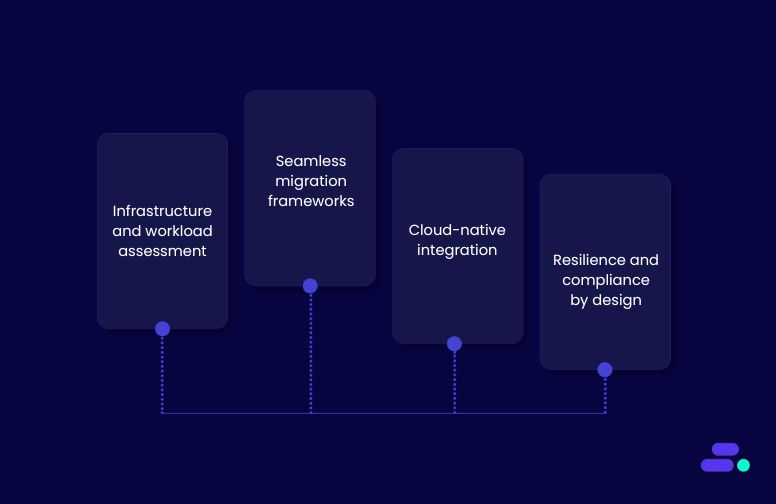
Migrating to the cloud isn’t just about shifting servers, but about rethinking how technology supports growth. Partnering with an AWS expert like Cloudtech gives SMBs access to proven migration frameworks, cost-optimized architectures, and strategies aligned with business goals. This ensures a move that minimizes disruption while unlocking scalability, security, and resilience.
Cloudtech’s edge lies in its SMB-first focus. It builds cloud environments that match lean budgets and dynamic growth needs, automates infrastructure to reduce overhead, and embeds compliance and resiliency from day one. Beyond migration, Cloudtech provides ongoing support so SMBs can innovate faster and stay ahead of larger competitors.
Key Cloudtech services for cloud migration and modernization:
- Infrastructure and workload assessment: Cloudtech evaluates current on-prem setups to pinpoint cost drains, bottlenecks, and risks, then maps out the most efficient migration paths to AWS.
- Seamless migration frameworks: Using AWS tools like Migration Hub and Application Migration Service, Cloudtech ensures workloads move securely and with minimal downtime, whether it’s databases, applications, or storage.
- Cloud-native integration: Once migrated, systems are connected with modern services such as analytics, AI, and automation, enabling SMBs to unlock value beyond simple “lift-and-shift.”
- Resilience and compliance by design: Cloudtech architects environments with multi-AZ redundancy, automated backups, and compliance controls, giving SMBs enterprise-grade reliability without enterprise costs.
Through these services, SMBs gain scalable infrastructure, reduced overhead, and the agility to innovate faster, all while staying focused on business growth.
See how other SMBs have modernized, scaled, and thrived with Cloudtech’s support →

Wrapping up
Modern business demands speed, scalability, and resilience. These are qualities on-prem infrastructure struggles to deliver. By moving to the cloud, SMBs can cut costs, scale instantly, and unlock advanced tools for security, analytics, and innovation.
Working with an AWS partner like Cloudtech ensures the transition isn’t just a lift-and-shift, but a strategic modernization. Cloudtech helps SMBs design lean, cloud-native architectures that are secure, compliant, and built to grow with the business.
With Cloudtech, SMBs gain the freedom to move beyond costly, rigid infrastructure and embrace a cloud foundation that fuels efficiency and competitiveness. Connect with Cloudtech today!
FAQs
1. How quickly can an SMB see benefits after moving to the cloud?
Most SMBs begin to see cost savings and performance improvements within weeks of migration, especially when workloads are re-architected for scalability and efficiency instead of simply “lifting and shifting.”
2. Is cloud migration disruptive to daily operations?
With the right strategy, migration can be phased to minimize downtime. AWS and partners like Cloudtech use automation, replication, and cutover planning to ensure business continuity throughout the process.
3. How does the cloud support future growth that SMBs can’t predict today?
Cloud platforms are elastic by design. SMBs can start small and scale resources up or down instantly, without the need for upfront hardware investment or long procurement cycles.
4. What about industries with strict compliance needs like healthcare or finance?
AWS offers services aligned with frameworks such as HIPAA, GDPR, and FINRA. Cloudtech ensures compliance requirements are built into the architecture so SMBs can innovate confidently without regulatory risk.
5. Can cloud adoption help SMBs attract and retain talent?
Yes. Modern cloud environments allow developers and IT teams to work with cutting-edge tools, automate routine tasks, and focus on innovation. This makes SMBs more appealing to skilled professionals compared to legacy-bound competitors.

Get started on your cloud modernization journey today!
Let Cloudtech build a modern AWS infrastructure that’s right for your business.

